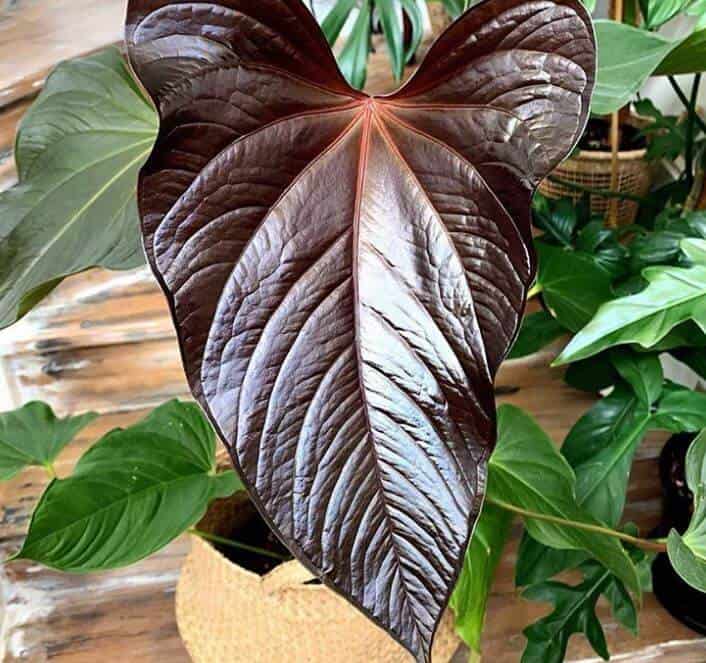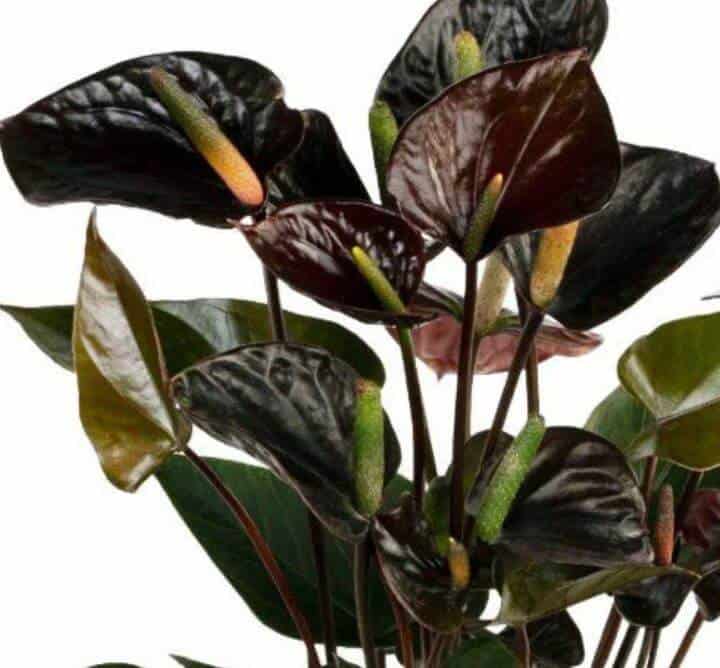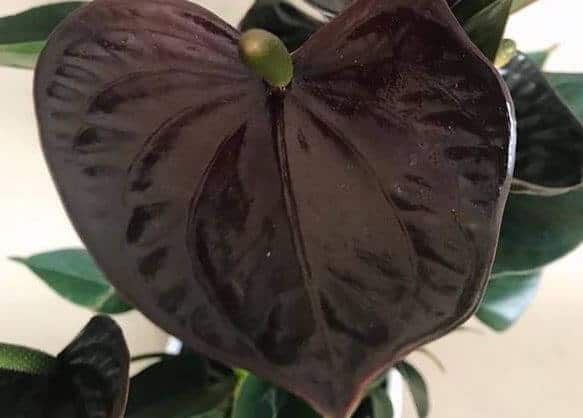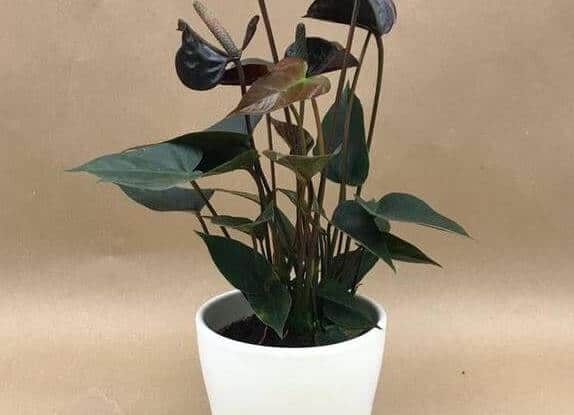Last Updated on January 7, 2023 by a Friendly Gardener
If you are passionate about Anthuriums or just love truly unique plants, a black anthurium plant is a must for your home garden collection. This chic plant is not your run-of-the-mill houseplant. It is an elegant, sturdy plant characterized by abundant long-lasting blooms and foliage in distinct hues. Heart-shaped flowers generally will last approximately three weeks.
The leaves are vivid green with specks of burgundy. Flower buds are a deep burgundy that slowly turns black as the blooms develop.
This is a tropical plant that finds its native habitat in South America. A member of the Araceae family, Anthuriums are epiphytes and boast more than 600 species. It can be cultivated outdoors in USDA hardy zones 10 through 12. As a tropical plant, it does well with indoor cultivation, reaching heights of roughly two feet and developing glossy leaves that alter in color with maturity.
Black Anthurium Plant Care

Soil
The Black Anthurium prefers a well-draining, slightly acidic growing medium. Soil pH should ideally measure between 5.5 and 6.5. Containers should have enough drainage holes to prevent excess moisture from suffocating the root system.
The challenge in formulating the proper growing medium is to ensure good drainage, yet some water retention. Orchid potting mix, amended with a bit of peat moss and sand, is recommended. Blend 70% orchid potting soil with 20% peat moss and 10% perlite or sand.
If you cannot blend such a soil mix, try orchid mix mixed with potting soil in equal parts.
Light
Anthuriums grow in tropical rainforests and typically attach themselves to tree trunks. They are not parasitic and use the hosting plant merely as a support structure. It will grow underneath a canopy of vegetation and trees, so the light will be filtered and dappled.
Ideally, your Black anthurium plant should be located in bright indirect lighting although it will adapt to most indirect lighting conditions including low light conditions. Nonetheless, should the lighting be too low, fewer blooms will develop. Black anthuriums should never be exposed to harsh, direct sunlight. If you have little light, consider supplementing light with a grow light.
Water
The Black Anthurium should be watered when the top two to three inches feel dry to the touch. Do not plan on establishing a regular watering schedule, but water when the soil dries partially. It’s essential to hydrate the root system without allowing the soil to become soggy. Reduce watering during the winter. Tap water can be used when not heavily chlorinated. If you have doubts about the amount of chlorine present, leave out a pitcher of water overnight so the chlorine can evaporate. The Black Anthurium is drought tolerant, so if you forget to water it, it should be fine all the same.
Humidity

The Anthurium’s tropical nature indicates that this plant enjoys humid environments. 80% indoor humidity is ideal. Mist the plant to assist with humidity levels. Plants should be kept away from heating and air conditioning vents. Space humidifiers, receptacles filled with water, or pebble trays can offer solutions if your home tends to have lower humidity levels.
Temperature
As a tropical species, the Black Anthurium likes warmth, so indoor temperatures should measure between 70° and 77° F. In the summer, your Anthurium can be moved outside for a spell. It should be returned indoors if evening temperatures drop below 50°F.
Feeding

A Black Anthurium will need occasional feeding. Plan on feeding your plant every two months during the growing season in spring and summer. Use a liquid fertilizer with higher levels of phosphorous diluted to a quarter of its strength, as highly concentrated fertilizer will burn and damage the root system. Reduce feeding during the winter and fall. Consider flushing the soil several times a year to eliminate salt buildup in the soil bed.
Pruning
It is only necessary to prune a Black Anthurium to remove spent flowers or dying foliage. Prune in spring if possible before the growing season takes off. Avoid pruning the principal stem or removing all leaves from your plant.
Potting and Repotting

Plan on repotting your Black Anthurium every two years unless it shows signs of being root-bound sooner. If roots peek from drainage holes or the soil bed, it’s time for repotting. Lack of new growth is also an indication. Only repot in the spring or at the beginning of summer.
A clay or terracotta planter will aid in the evaporation of excess water as well as the airflow around the root system. If you need to repot, select a pot approximately two inches larger.
During repotting, after the removal of the plant from the old container, disentangle any braided roots. Remove approximately 20% of the root system including any damaged or dead roots, to encourage regeneration.
Repotting plants is stressful to them. Expect your plant to need about a month to recover fully.
Black Anthurium Propagation

Black Anthuriums can be propagated using root division, stem cuttings, or seeds. Root division is the simplest and quickest method and can be done every several years. Split the plant into separate sections. Divide the root systems, and plant each new section in a separate container.
Propagation with seeds can take up to two years before a plant grows. Soak seeds for eight hours before germination. Prepare a seeding tray with a growing medium. Three seeds should be inserted into each tray compartment and then coated with a light covering of soil. Position the tray in a shaded spot and water daily. Cover the tray with plastic with several holes for moisture retention. After approximately ten days, seeds should sprout. When three to four leaves have developed, remove the plastic. After thirty to forty-five days, seedlings can be transplanted into pots.
Black Anthurium Problems
If your plant receives too little lighting, it may become leggy or develop leaves that are small. New leaves appear rarely, and the plant may have stunted growth.
Too much light will cause foliage to appear brown, crumbled, or burnt. Plants with an unhealthy appearance and soil that appears dry even after watering are symptomatic of excess light.
Yellowing foliage, or papules that appear on foliage and stems, are generally due to overwatering. New growth can feature tell-tale brown spots, and the crown may be subject to root rot.
Dried-out leaf tips, the loss or lack of blooms, and crinkly foliage, all point to underwatering or a lack of sufficient humidity.
If your plant is not flowering, it may be due to improper light, water, and humidity. It may also be from insufficient nutrients in the soil bed. To aid with flowers lasting longer, increase the humidity around the plant.
Pests
The Black Anthurium is susceptible to aphids and spider mites. Both are sap suckers and may invade in a humid environment. Spray your plant with insecticidal soap or an organic pesticide like Neem oil. If you notice evidence of a pest infestation, isolate the plant so that they do not spread to other plants.
Disease
The Black Anthurium is susceptible to bacterial and fungal infections. In particular, watch for powdery mildew, bacterial blight, and bacterial wilt.
Black Anthurium Toxicity
This plant is highly toxic if ingested by humans or pets due to the calcium oxalate crystals in the plant. Swelling and blisters will result from chewing the plant. If a pet has chewed or ingested any part of the plant, visit a veterinarian as soon as possible.

